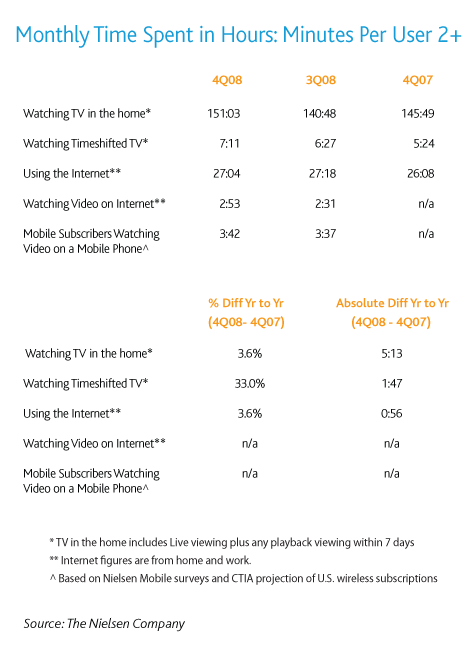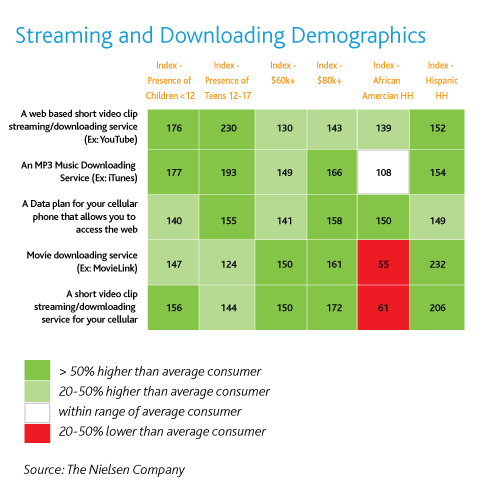
The Three Screen Trifecta: Mobile, Television & Internet
Dave Thomas, President, Global Media Client Services, The Nielsen Company
SUMMARY: Whoever said “content is king” was prescient. In today’s world, media is an on-demand experience with an array of platforms delivering rich content to on-the-go consumers via multiple devices. The fight for share of wallet is being played out on three screens: mobile, television and the Internet. So far, TV is winning.
Fact or Fiction?
A pioneering Video Consumer Mapping Study conducted on behalf of the Nielsen-funded Council for Research Excellence by the Ball State University Center for Media Design and Sequent Partners examined the current state of video media use by age group. Can you tell which of the following statements are true—or merely the media equivalent of ‘urban myths’?
| The tectonic plates of media options have shifted… |
No doubt about it, the media landscape has changed dramatically for consumers and advertisers alike. The tectonic plates of media options have shifted, and once-familiar terrain has experienced a radical make-over. There appears to be no upper limit on the public’s appetite for video, and the number of digital video alternatives, but three screens dictate the terms of entertainment: television, mobile devices and the Internet.
Apparently, cross-platform users opt for the “best screen available”, making their selection based on the quality of the screen experience, convenience, availability and schedule compatibility.
Timing is everything
At-home TV viewing recorded a remarkable 151+ hours per month for the typical Nielsen household in the last quarter of 2008. Internet users logged on for more than 27 viewing hours each month. Time-shifted TV viewing via devices like digital video recorders accounted for an additional 7+ hours per month—a 33% increase over the fourth quarter of 2007. Mobile subscribers consumed nearly four hours of video on a mobile phone and almost three hours looking at video on the Internet, thanks in large part to the Saturday Night Live candidate parodies posted on YouTube.

| When people access multiple screens, general TV viewing rises… |
Channeling TV
Several unique attributes account for television’s preeminent position: the ability to capture attention, create awareness and convey novelty effectively even in a cluttered environment. Together, these features are largely responsible for TV outpacing Internet use by a factor of 10. TV actually benefits from cross-platform viewing behavior. When people access multiple screens, general TV viewing rises. Despite the growing popularity of time-shifted viewing, with 3 of 10 households owning a digital video recorder, live TV is still a clear favorite with video fans.
Economic indicators
Video aficionados continue to invest in home entertainment versus other areas, albeit at a lower level, according to Nielsen. Apparently, consumers can’t live without the small screen. Currently, 54% of U.S. households have one or two TVs, 25% have three TVs and 21% own four or more sets. Overall, 63% of survey respondents reported changed spending habits, with 26% purchasing fewer videos or on-demand and pay-per-view movies/events.
Video streamers
Who are the primary consumers of video? Nielsen research reveals an audience that is young (households with teens have the highest incidence of streaming and downloading video), wealthy (streaming and downloading increases with income and registers much higher among $60,000+ households), and Latin (Hispanic households are more than twice as likely to download movies).

African-American households are less than half as likely as the average to download a video clip or movie to their cell phone, but exactly half more likely to access the web via their mobile phone.
| In the downloading game, networks pushed out video to 43% of the audience… |
Popular portals
How do viewers access video? YouTube absolutely dominates video streaming with two-thirds of viewers accessing clips through that web site. Still, in the downloading game, networks pushed out video to 43% of the audience, followed by Google (28%), news and cable networks both at 22%.
Results for music rang a very positive note for iTunes which is an almost monolithic presence with a 60% share of music downloads. Competitors Rhapsody and Amazon each carved out just slightly more than 6% of music download sales.
Mobile eyes
Like TV, cell phones and personal digital assistants (PDAs) enjoy unique points of difference that attract video viewers. Primarily, it’s ergonomic. The smaller screen provides a smaller visual field, requiring more concentration and focus to receive the message, which in turn bumps up retention. While the more emotional elements conveyed so well by TV may get lost—for example, it’s difficult to see facial expressions on a tiny screen—the speed and effectiveness of the medium more than compensate.
| The Internet poses an interesting marketing conundrum… |
Web wise
The Internet poses an interesting marketing conundrum. It is both the least effective of the three screens for commanding attention and building awareness, and the most effective in the latter stages of selling—powerful in its ability to persuade viewers to take action. Fully 91% of households have Internet access and 57% of homes have high-speed connections.
A Nielsen Consumer Audit determined that one reason for the ubiquity of Internet connection might be that the average $37 per month Internet provider charge is approximately half the cost of cell phone and TV service. Internet access correlates positively with families of children younger than 18, better educated and higher income households.
| 11% of people who watched the Academy Awards were logged onto the Internet… |
Video villages
One emerging trend that holds high potential for advertisers seeking to build consumer relationships is the “telecommunity”. Telecommunities comprise people who simultaneously watch TV and chat real time online about the program. During the Oscar telecast, 11% of people who watched the Academy Awards were logged onto the Internet, which represents about four times more simultaneous usage than normal.
Telecommunity members who connected via Facebook during the Oscars were online for 76 minutes and watched 50% more of the broadcast than the average Academy Award viewer. Twitter.com reported more than 100,000 Oscar-related “tweets” during the broadcast, an astonishing 400 messages per minute. Teens are more likely than adults to embrace these kinds of multi-tasking multi-media connections.
Social networks
Two-thirds of the world Internet population participates in social networking or blogging sites. This utilization represents almost 10% of all Internet time around the world according to the Nielsen Global Faces and Networked Places report.
| The fastest-growing segment of Facebook users are people age 35-49… |
One in every 11 online minutes globally gets spent on social network sites like Facebook and MySpace. In Brazil, a young, Internet-savvy population has driven that number to a remarkable 1 in every 4 Internet minutes. In the U.K., social network activity accounts for 1 in every 6 minutes. But it’s not just a young person’s game. The fastest-growing segment of Facebook users are people age 35-49, and the site added twice as many 50-64 year-olds as under-18 year-olds last year.
Different strokes
All of which goes to prove the point that there is a medium suited to every budget, age, gender and personality, and that we can expect the convergence trend to continue apace. Happy viewing!
For More Information:
Home Internet Access in the U.S.
This Nielsen Company report on home Internet access aggregates data from several different sources including the national and local television panels, the quarterly Home Technology phone survey (through 3rd quarter, 2008), and the Nielsen Claritas 2008 Convergence Audit survey, which is a combination of internet and mail respondents. The report notes differences in Internet access by geography and a number of socio-economic factors. Contact us for a free copy of this report.
Streaming Trends and Drivers
Nielsen’s quarterly Home Technology Report takes a pulse on usage and behavior surrounding technology consumption for Americans. The survey covers penetration rates for both technology devices and services/subscriptions. In addition, the survey includes questions on future purchases and current usage habits. Download a free copy of the Streaming Trends and Drivers Report.
Three Screen Report
In its quarterly Three Screen report, Nielsen reported that Americans spent more time this quarter using the “Three Screens” than they did during the same time period last year. The report revealed updates on timeshifted viewing behavior and its relationship to online video viewing. Other insights revealed include the demographic breakdown of mobile video viewers, DVR penetration and streaming video usage.
This quarter, the A2/M2 Three Screen Report reveals that the average American watches more than 151 hours of TV per month, an all-time high. They are also watching several hours of video on other devices: those who watch it on the Internet consume another 3 hours of online video per month, and those who use mobile video watch nearly 4 hours per month on mobile phones and other devices.



